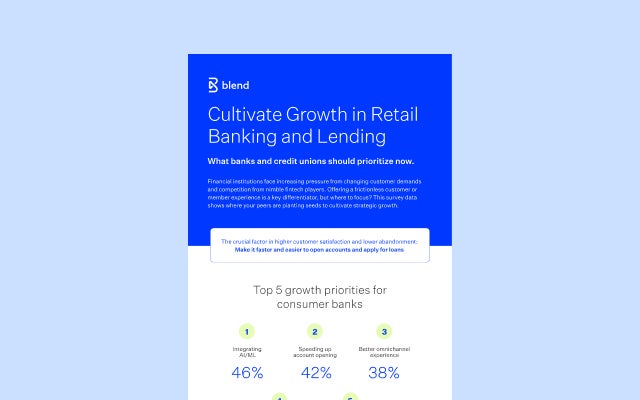July 15, 2022 in Thought leadership
The latest digital lending trends impacting financial services
Advances in artificial intelligence, machine learning, automation, and the cloud are redefining what’s possible for borrowers and lenders.

In the midst of the pandemic, financial institutions found themselves having to adopt and optimize technology much faster than ever before.
Unpack insights—at your leisure.
Subscribe for industry trends, product updates, and much more.
“Many banks that were taking an incremental approach to digital were shocked into reality during 2020, and executives realized greater investment and faster transformation is needed to stay relevant,” said Steve Williams, president of Cornerstone Advisors, in a recent report.
While financial services companies are still feeling this seismic shift, technology continues to advance at breakneck speed. Navigating this change is no easy feat. That’s why it’s important to look ahead and determine which technological innovations are worth investing in now. Let’s unpack five digital lending trends that pioneering firms are prioritizing.
Trend #1: AI is improving profitability
By 2035, artificial intelligence (AI) could improve the profit potential of businesses by an average of 38% across 16 industries. For financial firms, AI is already making its mark. AI reduces manual processes and automates the lending process for customers and loan teams.
With AI as part of their workflow, lenders can:
- Quickly assess borrower information to make intelligent suggestions on products that are more likely to suit their needs
- Dynamically assess the solvency of a customer to reduce delinquency rates and minimize profit losses
- Answer the most common customer questions using AI-powered chatbots and guide applicants through the loan application process, reducing the burden on lending staff
Trend #2: End-to-end automation is delivering new efficiencies
Automation could save banks up to $70 billion by 2025. Process automation, especially when it is enhanced by AI, can complete many of the manual repetitive tasks that have traditionally been a burden to lending teams — and it can do this across the entire loan experience. Here’s how:
- Information already provided by the customer can be used to pre-fill a loan application
- Data connectivity can automate applications with accurate and validated data and identity information, such as assets and payroll
- Missing or inaccurate data can be flagged automatically, minimizing bottlenecks later on
Trend #3: The cloud is becoming the platform of choice
The cloud can be considered one of the most significant digital lending trends because of its ability to help financial firms deliver services, manage documents, store information, and process data online. It’s no wonder that more than 90% of banks now have at least a moderate level of workloads operating in the cloud today.
With a cloud-based digital lending platform, lending firms can:
- Roll out the latest technology rapidly
- Empower loan officers to work wherever they are, simply by logging in from their mobile device or laptop
- Ensure customers benefit from a consistent loan application experience, whatever product they choose, no matter where or when they choose to apply for it
Trend #4: Hyper-personalization is transforming the customer experience
The benefits of delivering a more personalized customer experience have been widely documented. A commissioned study conducted by Forrester Consulting on behalf of Blend showed that 71% of banking decision-makers plan to increase their investment in personalization next year.
Digital lending can help lenders achieve personalization in the following ways:
- Delivering timely, relevant offers to customers at exactly the right moment — and in the channel of their choice
- Anticipating what a customer might want before they signal it to their financial provider, providing personalized rates, credit terms, or pre-approval without extensive work by lending teams
- Differentiating themselves while boosting profits and improving the customer experience at the same time
Trend #5: Creating a “total experience” is improving satisfaction rates
More and more lenders are looking to improve the lending experience not just for borrowers, but for lending staff too. This means focusing on the “total experience,” a term coined by Gartner to describe a strategy that brings together multiple experiences including the customer experience, employee experience, and user experience. In fact, the analyst forecasts that, by 2024, institutions providing a total experience will outpace competitors by 25% in terms of both employee and customer satisfaction.
As a result, modern digital lending platforms are built with the total experience in mind and offer borrowers and lenders alike a raft of benefits including:
- Streamlined application flows
- An intuitive user interface
- A consistent user experience across all products, every time
As we move beyond 2022, more trends will continue to transform the face of financial services. While lenders cannot predict that future, with the help of technology, they can put themselves in a strong position to adapt as quickly as possible. Many digital lending platforms are helping banks to quickly leverage digital lending trends as they emerge and stay one step ahead in a landscape that is constantly evolving.

Ready to explore beyond digital lending in 2022?
Find out what we're up to!
Subscribe to get Blend news, customer stories, events, and industry insights.


